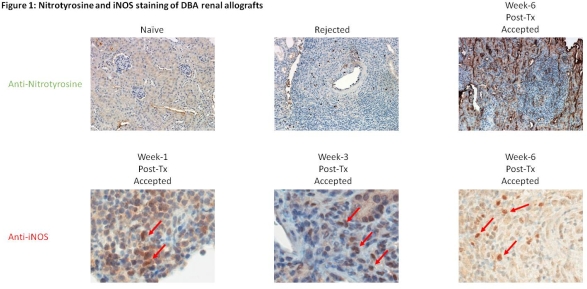Accepted Mouse Kidney Allografts Are Characterized by Widespread Nitrosylation.
Center for Transplantation Sciences, Dept. of Surgery, Dept. of Pathology, Massachusetts General Hospital, Boston, MA.
Meeting: 2016 American Transplant Congress
Abstract number: D303
Keywords: Kidney transplantation, Nitric oxide, Tolerance
Session Information
Session Name: Poster Session D: Late Breaking
Session Type: Poster Session
Date: Tuesday, June 14, 2016
Session Time: 6:00pm-7:00pm
 Presentation Time: 6:00pm-7:00pm
Presentation Time: 6:00pm-7:00pm
Location: Halls C&D
Leukocytes can modulate the immune response through manipulation of amino acid metabolism. Research indicates that depletion of L-arginine and generation of nitric oxide (NO) suppresses the immune system by impairing T-cell function. Once released into the microenvironment, reactive nitrogen intermediates interact with nucleic acids and proteins to regulate various biological processes. iNOS expressing cells, such as CD11b+ subsets, have been studied in the context of tumor progression and infectious disease; however, their potential to induce transplant tolerance is unclear. The aim of this study is to examine nitrosylation levels and iNOS expressing cells across murine renal allografts. DBA donor kidneys were transplanted into B6 recipients and were euthanized after 1, 3, and 6 weeks. Nitrosylation was assessed by immunohistochemistry (IHC) using anti-nitrotyrosine and anti-iNOS unconjugated antibodies. CD11b+ cells were isolated from 6 week kidney allografts, and analyzed with IHC and flow cytometry. IHC confirmed that accepted allografts were heavily nitrosylated. Interestingly, rejected cohorts from the same strain combination following Treg depletion, showed little sign of NO deposition on renal graft tissue. IHC indicated that iNOS positive cells were present in lymphocytic infiltrate as early as 1 week and persisted at 6 weeks. IHC illustrated that CD11b+ cell localize to Treg-rich organized lymphoid structures (TOLS), which form after 3 weeks and are signature structures for kidney acceptance formation. Moreover, flow cytometric analysis demonstrated that CD11b+ iNOS+ cells were present in the accepted graft. Accepted renal allografts are distinct from rejected allografts with respect to nitrosylation. The presence of iNOS+ cells shows that NO production is occurring within the kidney microenvironment. CD11b+ cells within the TOLS of the graft are one source of NO production. Our results show the possibility of NO playing a role in graft acceptance and implicate myeloid progenitors in this process.

CITATION INFORMATION: Aljabban I, Jiang B, Yang C, Ndishabandi D, White R, Russell P, Madsen J, Colvin R, Alessandrini A. Accepted Mouse Kidney Allografts Are Characterized by Widespread Nitrosylation. Am J Transplant. 2016;16 (suppl 3).
To cite this abstract in AMA style:
Aljabban I, Jiang B, Yang C, Ndishabandi D, White R, Russell P, Madsen J, Colvin R, Alessandrini A. Accepted Mouse Kidney Allografts Are Characterized by Widespread Nitrosylation. [abstract]. Am J Transplant. 2016; 16 (suppl 3). https://atcmeetingabstracts.com/abstract/accepted-mouse-kidney-allografts-are-characterized-by-widespread-nitrosylation/. Accessed December 13, 2025.« Back to 2016 American Transplant Congress
